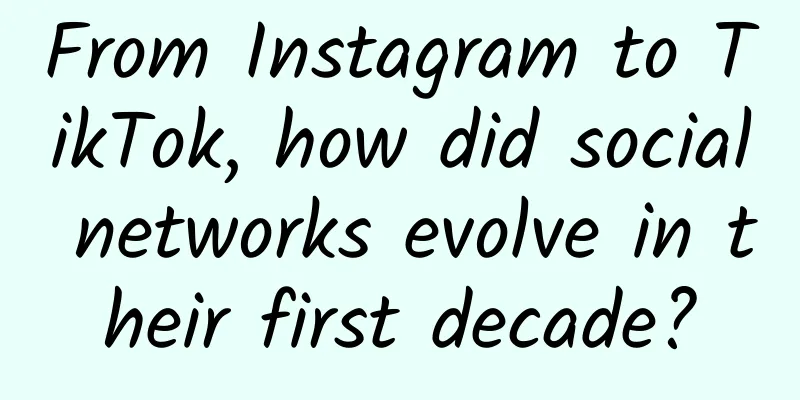From Instagram to TikTok, how did social networks evolve in their first decade?

|
Author | Qianshui At midnight on October 6, 2010, a new app built by a small team was officially launched on the App Store. Then someone noticed that they had registered an app called Instagram. But when it was launched at 6 a.m., it still overwhelmed the server and had to be rebuilt. Instagram co-founders Mike Krieger and Kevin Systrom in their San Francisco office in 2011. Instagram then attracted more than 100,000 installs in less than a week, making it one of the fastest-growing apps at the time. By December, that number had soared to 1 million, and Instagram co-founder Kevin Systrom predicted at the time that “image-based social networking” would “take off” in the next few years. By the end of 2019, Instagram had more than 1 billion users worldwide, making it one of the world's hottest tech companies. But it is now facing a strong new competitor, TikTok, from China's ByteDance, which is developing at the same pace as Instagram in the early 2010s. Instagram must think clearly about one question: “Image social networking” has indeed taken off, but will “video social networking” replace it in the next decade? Instagram's past decade is the decade of the deepest and broadest evolution of the social media landscape. At that time, small startups still had ample opportunities to compete with more mature companies, and it could achieve huge success in the App Store. In 2012, Instagram was acquired by Facebook for a sky-high price of $1 billion, marking the beginning of the merger of the entire technology industry. In recent years, Instagram has been imitating the network functions of competitors such as Snapchat and TikTok to adapt to the changing user habits. Like its parent company Facebook, Instagram also has to face the dark side of its platform, from misinformation to cyberbullying. “When Instagram was first created, it was primarily about following people without permission, sharing permanent photos with a large number of people, and sharing as many times as you want,” said Josh Miller, Facebook’s former head of product. Now, like many of its peers in the social media industry, Instagram is focusing on ephemeral posts (like Snapchat’s disappearing messages), experimenting with 15-second music videos (Tik Tok), and offering the option to share privately rather than publicly. Social media has moved from its early distinctive styles to a fusion of functions. Here is a timeline of the events that drove social media this decade:
(1) On the eve of its IPO, Facebook agreed to acquire Instagram for $1 billion, a staggering sum at the time. (2) Facebook reaches 1 billion monthly active users, a milestone that highlights its incredible reach. By the end of 2019, it will have more than 2 billion active users.
(1) Twitter went public but flopped on Wall Street as investors realized its audience size would never match Facebook’s. (2) According to The Wall Street Journal, Snapchat rejected Facebook’s $3 billion acquisition offer.
(1) Twitter shut down Vine, a popular app for sharing six-second video clips. (2) Chinese startup Bytedance acquired the lip-syncing platform Musical.ly and subsequently transferred its users to TikTok.
Supplementary information: CNN Facebook Social Throne When Instagram launched, Facebook was almost synonymous with social media, but it was far from the dominant position it has today. Other tech giants, including Google and Apple, have also tried to build their own social products. Snapchat was launched in 2011, and Twitter went public in 2013. For a time, Wall Street had an illusion that so many social networks could coexist. However, there are only 24 hours in a day, and users only have so much attention and time. The result of coexistence is to grab the attention of the original social network, and Facebook certainly won't allow this to happen. Since then, Google has shut down Google+, while Apple's music social network Ping never took off. Twitter's monthly active users have stagnated at around 300 million, a far cry from Facebook's 2.45 billion monthly users. Snapchat set the tone for a decade of rapid development by creating a unique "episode-destructing" feature. It has proven to have advantages over other mainstream products. "When Snapchat launched, it offered a completely different way to communicate," said one Wall Street analyst. "What ended up happening is that Snapchat changed the way young people communicate to a large extent, but it didn't take over with the older demographic the way Facebook did." By the end of 2019, the trend in the social industry was close to being clear. After acquiring Instagram, Facebook acquired the messaging platform WhatsApp for $22 billion in 2014. Facebook also reportedly tried to acquire Snapchat for $3 billion in 2013, but founder and CEO Evan Spiegel refused. In the second half of this decade, many other social products were launched, but unlike Instagram and Snapchat, they were never seen as true competitors to Facebook. These applications include: Peach, Meerkat, Mastodon, Vero, etc. Instagram’s LOGO in 2012 For a while, it looked like Instagram would maintain its independence even after being acquired. “Facebook made Instagram an island, which launched a standalone app and did things differently from Facebook,” said John Barnett, who joined Instagram as a product manager in 2014 when the company had fewer than 75 employees. But it won’t last. In 2018, Instagram co-founders Systrom and Mike Krieger reportedly resigned due to tensions with Facebook CEO Mark Zuckerberg over the direction of Instagram. Facebook recently added the words “from Facebook” to the Instagram app while referring to Instagram’s public relations staff as “Facebook Company” spokespersons. This series of measures proves that Facebook is increasing its control over Instagram and independence is no longer possible. Through Instagram, WhatsApp, Messenger and its namesake app, Facebook has four platforms, each with more than 1 billion users. It’s clear that FB has established such an absolute dominance in the social space that more and more politicians and organizations are calling for Facebook to be broken up. Democratic presidential candidate Elizabeth Warren has suggested that Facebook should spin off Instagram in particular. Facebook’s reputation has also suffered a major blow after it was revealed that Cambridge Analytica obtained the personal data of up to 87 million Facebook users, triggering a major privacy awakening across the tech sector. (Mark Zuckerberg speaking at the F8 developer conference in 2010) Is TikTok considered social? As the first decade of social media comes to an end, social media companies find themselves still on the defensive. Social networks, once seen as a convenient way to socialize on the Internet, have been increasingly criticized for spreading misinformation, leading to election interference and user privacy breaches, not to mention issues such as social addiction and online bullying. After a series of public opinion crises, Instagram and Facebook are reconsidering the relationship between market share and social responsibility. Twitter is committed to improving happiness, and YouTube has begun to simplify the number of subscribers on the platform to help address its star creators' concerns about revenue pressure. After crisis after crisis, social products have reshaped the belief in the role of social products in building direct relationships between people. It is against this backdrop that TikTok began to take off. Launched in 2016, TikTok’s purpose is to share short, viral videos, which attracted a large number of views and fans. This is reminiscent of Vine, the six-second video service product acquired by Twitter, which was shut down in 2017. (TikTok has been downloaded nearly 1.6 billion times worldwide) In China, short video apps such as Douyin and Kuaishou have become super apps with more than 300 million monthly active users. Capital and user time are all poured into the short video field. They do not require professional filming or fixed locations, and they are always leading the trend of social life. A Cornell University professor who studies social media believes that TikTok is completely different from Facebook and Instagram. She said: "There is no point in building social connections." "It just uses algorithms to find content that attracts people's attention. It is an entertainment-based platform." This differentiation has brought it huge popularity. According to Sensor Tower data, TikTok has been installed nearly 1.6 billion times worldwide so far. Ironically, TikTok has attracted a considerable number of users from Instagram, and ByteDance has been crazy and blindly burning money to promote Tik Tok in the North American market in order to occupy the market and alarm other social products. Facebook and Instagram have long noticed TikTok's success and released their own copycat apps. In 2018, Facebook launched an app called Lasso that lets users create and share short videos with music and camera effects. Earlier this year, Instagram launched a new tool in Brazil called "Reels" for sharing 15-second videos with music. How will social media evolve in the next decade? Undoubtedly, technological innovation has driven the biggest changes in social media over the past decade, especially smartphone cameras and augmented reality technology, which have enabled faster connectivity for social products, allowing people to upload Stories or TikTok videos in seconds. In the future, the popularization of 5G will be able to further promote the development of social media and make way for more interactive content and VR games. Miller, the former Facebook product chief, believes the next decade will make it more like people are in the same room, in the same scene, with distant people. “A lot of our social media experiences are poor substitutes for physical presence,” he said. “It’s hard to predict what advances in hardware will bring, but I hope that one day I’ll be able to sit down in my apartment in Brooklyn and I’ll look across at my kitchen table and see my mom eating dinner in Los Angeles.” |
<<: CIRP: 23% of iPhone users say the battery no longer lasts a full day after one year
Recommend
Treatment for postpartum melanin
Postpartum melanin, many young mothers will have ...
How to prune petunias? Can long-flowered petunias be grown on the balcony?
Petunia is a very common flower plant, and if it ...
Can onions, ginger and garlic be added to confinement meals?
During the confinement period, dietary adjustment...
Demonstration of squatting exercise in late pregnancy
How do pregnant women do squat exercises? Regardi...
Flexion: From January to March 2012, the output value of mobile applications using the Flexion platform reached 4.45 million euros
Mobile analytics platform Flexion recently releas...
How to adjust the indoor temperature during confinement in winter
It is very difficult to deal with confinement in ...
How to treat congenital uterine displacement?
The uterus is known as the palace of fertility, a...
Helicobacter pylori is on the rise again. Don’t believe the rumors and take preventive measures as soon as possible.
Recently, the topic #Infection with Helicobacter ...
Is it better to put old pumpkin or young pumpkin under steamed pork with rice flour? Which pumpkin is better for steamed pork with rice flour?
As we all know, steamed pork with rice flour is a...
Pregnancy test pictures
In today's modern society with rapid developm...
Sea salt, iodized salt, low sodium salt...how to choose among different types of salt?
When you go to the supermarket to buy salt, you w...
Eye bags or under-eye bags, can’t tell the difference?
What?! There are still people who don’t know what...
How about crow's feet wrinkle removal surgery?
Many people are afraid of aging and pursue younge...
What kind of fish soup is best to drink after abortion
Having an abortion is a very helpless thing for m...
The latest research! This food additive may increase the risk of diabetes and cardiovascular disease, hidden in these foods...
Ice cream is delicious and refreshing, and is lov...









